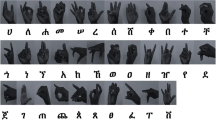Abstract
With the change in technology at such a fast pace, every piece of information is available on the Internet. But certain sections of society like deaf-mute persons are still struggling for their communication rights. They use countenance, kinesics, and gestures to communicate with each other. Further, due to the paucity of linguistically annotated and documented material on Sign Language, research on grammatical and phonetic aspects of the language is limited. Despite the well-established purposes of Sign Language, the use of technology to facilitate deaf persons is under-explored in research studies. Consequently, the design of an efficient and automatic Indian Sign Language Translation System (ISLTS) is essential. This paper proposes a deep learning-based seven-layered two-dimensional Convolution Neural Network (2D-CNN) for efficient translation of Indian sign language digits using the swish activation function. The proposed framework uses max pooling, batch normalization, dropout regularization, and Adam optimizer. An open-access numeric customized dataset of India Sign language of approximately 12 K images has been utilized. Our model achieves the highest validation accuracy of 99.55% and average validation accuracy of 99.22%. The results show that the swish activation function outperforms traditional ReLU and Leaky ReLU activation functions.
Access this chapter
Tax calculation will be finalised at checkout
Purchases are for personal use only
Similar content being viewed by others
References
Shivashankara, S., Srinath, S.: American sign language recognition system: an optimal approach. IJIGSP 10, 18–30 (2018)
ISLRTC. History | Indian sign language research and training center (ISLRTC), Government of India. Indian Sign Language Research and Training Center (ISLRTC) (2022). http://islrtc.nic.in/history-0
Varun Chand, H., Karthikeyan, J.: CNN based driver drowsiness detection system using emotion analysis. IASC 31, 717–728 (2022)
Sitender, Bawa, S.: Sanskrit to universal networking language EnConverter system based on deep learning and context-free grammar. Multimed. Syst. 28, 2105–2121 (2022). https://doi.org/10.1007/s00530-020-00692-3
Sharma, S., Singh, S.: Recognition of Indian sign language (ISL) using deep learning model. Wireless Pers. Commun. 123, 671–692 (2021)
PRATHUM ARIKERI. Indian sign language (ISL). Kaggle https://www.kaggle.com/datasets/prathumarikeri/indian-sign-language-isl
PRATHUM ARIKERI. American sign language (ASL) dataset. Kaggle https://www.kaggle.com/datasets/prathumarikeri/american-sign-language-09az
Das, A., Gawde, S., Suratwala, K., Kalbande, D.: Sign language recognition using deep learning on custom processed static gesture images. In: 2018 International Conference on Smart City and Emerging Technology (ICSCET), pp. 1–6. IEEE (2018). https://doi.org/10.1109/ICSCET.2018.8537248
Kothadiya, D., et al.: Deepsign: sign language detection and recognition using deep learning. Electronics 11, 1780 (2022)
Rinalduzzi, M., et al.: Gesture recognition of sign language alphabet using a magnetic positioning system. Appl. Sci. 11, 5594 (2021)
Mannan, A., et al.: Hypertuned deep convolutional neural network for sign language recognition. Comput. Intell. Neurosci. 2022, 1–10 (2022)
Kasapbaşi, A., Elbushra, A.E.A., Al-Hardanee, O., Yilmaz, A.: DeepASLR: a CNN based human computer interface for American sign language recognition for hearing-impaired individuals. Comput. Methods Programs Biomed. Update 2, 100048 (2022)
Martinez-Martin, E., Morillas-Espejo, F.: Deep learning techniques for spanish sign language interpretation. Comput. Intell. Neurosci. 2021, 1–10 (2021)
Myagila, K., Kilavo, H.: A comparative study on performance of SVM and CNN in Tanzania sign language translation using image recognition. Appl. Artif. Intell. 36, 2005297 (2022)
Yirtici, T., Yurtkan, K.: Regional-CNN-based enhanced Turkish sign language recognition. SIViP 16, 1305–1311 (2021). https://doi.org/10.1007/s11760-021-02082-2
Nandi, U., Ghorai, A., Singh, M.M., Changdar, C., Bhakta, S., Kumar Pal, R.: Indian sign language alphabet recognition system using CNN with diffGrad optimizer and stochastic pooling. Multimed. Tools Appl. 82, 9627–9648 (2021). https://doi.org/10.1007/s11042-021-11595-4
Dudhal, A., Mathkar, H., Jain, A., Kadam, O., Shirole, M.: Hybrid SIFT feature extraction approach for Indian sign language recognition system based on CNN. In: Pandian, D., Fernando, X., Baig, Z., Shi, F. (eds.) ISMAC 2018. LNCVB, vol. 30, pp. 727–738. Springer, Cham (2019). https://doi.org/10.1007/978-3-030-00665-5_72
Wang, Y., Li, Y., Song, Y., Rong, X.: The influence of the activation function in a convolution neural network model of facial expression recognition. Appl. Sci. 10, 1897 (2020)
Adu, K., Yu, Y., Cai, J., Asare, I., Quahin, J.: The influence of the activation function in a capsule network for brain tumor type classification. Int. J. Imaging Syst. Technol. 32, 123–143 (2022)
Rajarajeswari, S., Renji, N.M., Kumari, P., Keshavamurthy, M., Kruthika, K.: Real-time translation of Indian sign language to assist the hearing and speech impaired. In: Roy, S., Sinwar, D., Perumal, T., Slowik, A., Tavares, J.M.R.S. (eds.) Innovations in Computational Intelligence and Computer Vision. AISC, vol. 1424, pp. 303–322. Springer, Singapore (2022). https://doi.org/10.1007/978-981-19-0475-2_28
Kumar, N.: Thresholding in salient object detection: a survey. Multimed. Tools Appl. 77(15), 19139–19170 (2017). https://doi.org/10.1007/s11042-017-5329-y
Tyagi, A., Bansal, S.: Hybrid FiST_CNN approach for feature extraction for vision-based Indian sign language recognition. IAJIT 19(3), 403–411 (2022)
Dhiman, R., Joshi, G., Rama Krishna, C.: A deep learning approach for Indian sign language gesture classification with different backgrounds. J. Phys. Conf. Ser. 1950, 012020 (2021)
Katoch, S., Singh, V., Tiwary, U.S.: Indian sign language recognition system using SURF with SVM and CNN. Array 14, 100141 (2022)
Author information
Authors and Affiliations
Corresponding author
Editor information
Editors and Affiliations
Rights and permissions
Copyright information
© 2023 The Author(s), under exclusive license to Springer Nature Switzerland AG
About this paper
Cite this paper
Sabharwal, S., Singla, P. (2023). Indian Sign Language Digit Translation Using CNN with Swish Activation Function. In: Garg, L., et al. Key Digital Trends Shaping the Future of Information and Management Science. ISMS 2022. Lecture Notes in Networks and Systems, vol 671. Springer, Cham. https://doi.org/10.1007/978-3-031-31153-6_21
Download citation
DOI: https://doi.org/10.1007/978-3-031-31153-6_21
Published:
Publisher Name: Springer, Cham
Print ISBN: 978-3-031-31152-9
Online ISBN: 978-3-031-31153-6
eBook Packages: Intelligent Technologies and RoboticsIntelligent Technologies and Robotics (R0)




